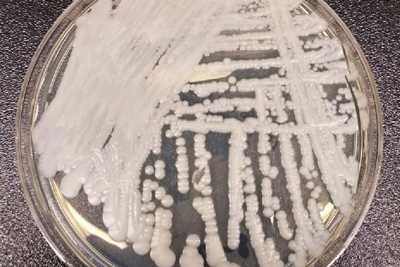AMD Project: Hunting Down Healthcare-associated Fungal Infections
Using AMD to track a dangerous multi-drug resistant yeast

Candida auris is an emerging multidrug resistant fungus that presents a serious global health threat. C. auris is difficult to identify with standard laboratory methods, and can be misidentified in labs without AMD technology.
In June 2016, CDC alerted hospitals and clinicians in the United States to be on the lookout for a dangerous multi-drug resistant yeast, Candida auris. CDC had received reports that this yeast had caused severe illness in hospitalized patients in several countries and officials feared we may soon see cases in this country, as well. Before this alert went out, C. auris had not been detected in the U.S. But after CDC raised the alarm, several hospital laboratories reported suspected cases. Without specialized testing, C. auris can be misidentified as a less dangerous type of yeast. So, several state and local health departments, together with CDC, began using advanced molecular detection (AMD) to test patient samples that were positive for other types of yeast. AMD methods revealed over 30 patients infected with C. auris and CDC scientists are continuing to investigate this deadly yeast.
One of the most frightening aspects of C. auris is that it strikes people where they are most vulnerable, in hospitals and healthcare settings. In some patients, C. auris can enter the bloodstream and spread throughout the body, causing serious invasive infections. Commonly used antifungal drugs often do not work against C. auris, so infections are difficult to treat. In addition, once the yeast is in healthcare settings, it can be hard to get rid of, even with thorough infection control and cleaning measures.
To address this new danger, CDC is using AMD to detect and analyze this yeast by studying detailed DNA fingerprints of C. auris from specimens collected in the regions where it was first identified. Through these investigations, scientists have learned that the yeast seemed to emerge simultaneously in eastern and southern Asia, southern Africa, and South America. In addition, they are discovering that DNA from specimens within each region are quite similar to one another, but are relatively different across regions, suggesting C. auris emerged independently in multiple regions at roughly the same time. But no one is certain how C. auris appeared in different places at the same time, why we are seeing it now, what part of the environment it came from, or how it began infecting people.
By using AMD, CDC scientists hope to determine how C. auris strains are related and understand how it is spreading, not just in healthcare settings and the U.S., but around the world, as well. In this project, researchers hope to devise ways to detect, control, and stop the spread of this potentially deadly pathogen.
- Page last reviewed: March 27, 2017
- Page last updated: March 27, 2017
- Content source:


 ShareCompartir
ShareCompartir